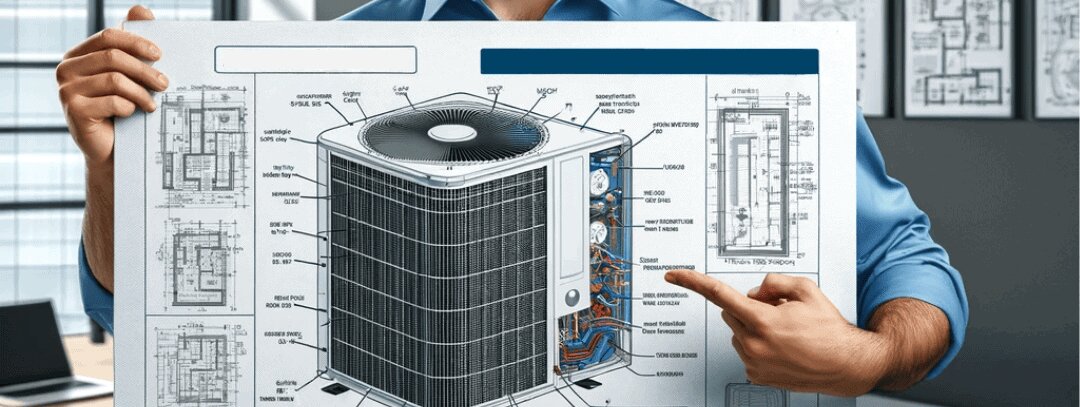Decode the Jargon: Understanding Ductless Mini Split System Specifications
Looking to upgrade your home's heating and cooling but getting lost in the HVAC jargon? This guide breaks down everything you need to know about ductless mini split systems, from efficiency to installation, so you can make the right choice for your space.
Table of Contents:

Understanding Ductless Mini Split System Specifications
One of the reasons ductless mini split systems are considered a go-to choice for home climate control is their ability to provide zoned temperature control.
Ductless Mini Split Systems 101
Ductless mini split systems are gaining popularity as an energy-efficient alternative to traditional heating and cooling methods. These systems are called "ductless" because they do not require a network of ducts throughout the home to operate, unlike conventional central air conditioning systems. A mini split has two main components: an outdoor compressor/condenser and one or more indoor air-handling units. These components are connected by a conduit that houses the power cable, refrigerant tubing, suction tubing, and a condensate drain. The system operates by transferring heat between the inside and outside of the building, offering both heating and cooling capabilities, which can lead to significant energy savings. Moreover, the absence of ducts reduces energy losses associated with ductwork of central forced air systems, often found in attics or basements.
One of the reasons ductless mini split systems are considered a go-to choice for home climate control is their ability to provide zoned temperature control. Each indoor unit can be controlled independently, allowing different rooms or zones within a home to be heated or cooled to different temperatures. This not only enhances personal comfort but also reduces energy consumption because only the areas in use need to be conditioned, avoiding the waste of energy in heating or cooling unoccupied spaces. Additionally, installation is typically quicker and less invasive than that of ducted systems since it doesn't require building and installing ductwork throughout the property.

Key Components Explained
At the heart of the mini split system are two key components: the indoor and outdoor units, which are designed to work in tandem. The outdoor unit, containing the compressor, condenser coil, and expansion valve, is responsible for the exchange of heat with the outside air. The compressor pumps refrigerant through the system, which absorbs heat inside the home when in cooling mode and releases heat inside when in heating mode. The outdoor unit is often compact and can be placed in a discreet location outside the home. Inside the house, the indoor units, often wall-mounted, include a fan and evaporator coils and are responsible for distributing the conditioned air into the room. Because each room or zone can have its own indoor unit, this allows for greater individual control over the climate in each space, leading to a more customized comfort experience. The sleek design of these units enables them to blend into the décor with minimal disruption. A remote control or wall-mounted thermostat typically controls the temperature settings, fan speed, and other features such as timers and sleep functions, making it easy to maintain the desired comfort level.
One of the most significant advantages of ductless mini split systems over traditional HVAC systems is their operational efficiency. The absence of ductwork minimizes the energy losses that are typical in ducted systems, especially when ducts are not well insulated or are located in unconditioned spaces like attics or crawl spaces. Duct losses can account for more than 30% of energy consumption for space conditioning, especially if the ducts are in an unconditioned space. With mini splits, this loss is virtually eliminated, leading to lower utility bills and a reduced environmental impact. Moreover, ductless systems offer unparalleled flexibility in terms of installation and design. They are ideal for homes without existing ductwork, for room additions, or for spaces where extending or installing ductwork is impractical or too costly. They also provide a solution for buildings with heating systems, such as hot water heat, radiant panels, or space heaters that do not use air ducts. Additionally, mini splits have the flexibility to fit into various interior design schemes, with options that include wall-mounted, ceiling-recessed, or floor-standing models. Homeowners can also enjoy improved indoor air quality as ductless systems typically have multi-stage filtration that can drastically reduce dust, bacteria, pollen, allergens, and other particulates in the air.

Deciphering Technical Specifications
Understanding BTUs:
British Thermal Units (BTUs) are the traditional measurement unit for heat, commonly used to quantify the energy performance of heating and cooling systems, such as air conditioners. When determining the correct BTU capacity for a room, it's essential to ensure that the air conditioning unit can efficiently manage the temperature without wasting energy. A unit with too many BTUs can lead to unnecessary power consumption and overcooling, whereas an underpowered unit will struggle to cool the room effectively, leading to increased wear and tear on the system. Therefore, using a BTU calculator to find the appropriate capacity is crucial for maintaining optimal comfort and efficiency in a space.
An accurately calculated BTU capacity ensures that the air conditioner can handle the heat load of the room, which includes factors like room dimensions, number of occupants, sun exposure, and the presence of heat-producing appliances. A well-sized air conditioner will cycle on and off properly, maintaining a steady and comfortable temperature while also dehumidifying the air effectively. This balancing act not only provides a comfortable environment but also contributes to the energy efficiency of the home or office, potentially leading to lower electricity bills and a reduced environmental footprint.
Calculating the Right Size:
The correct output power for an air conditioning unit is not a one-size-fits-all figure; it requires careful consideration of the specific room's dimensions. Calculating the right size involves a comprehensive room size calculator that can translate square footage into the necessary BTU capacity. This ensures that the unit is neither overpowered—leading to wasted energy and undue stress on the unit from short cycling—nor underpowered, which would mean it is constantly running and struggling to cool the space adequately.
Moreover, the right size air conditioning unit will result in longer life expectancy for the appliance, as proper sizing means the unit is not overworked. It will also maintain better humidity control, which is crucial for comfort and to prevent mold growth. A calculator that takes into account the room's dimensions provides a tailored recommendation, thereby simplifying the decision-making process when selecting an air conditioning system. Without such calculations, consumers might base their decisions on rough estimates, which could lead to inefficient cooling and higher long-term costs.
Tailoring to Your Space:
To tailor an air conditioning unit to a specific space, a detailed AC BTU calculator is employed. This calculator requires input on room dimensions, ceiling height, window sizes, and even geographic location, as all these factors influence the room's cooling requirements. Ceiling height, for example, can significantly affect the volume of air within a space that needs cooling. Higher ceilings mean more air, thereby increasing the need for a higher BTU capacity. Geographic location matters as well, with rooms in sunnier or hotter climates requiring a higher BTU rating compared to similar rooms in cooler areas.
These detailed calculators often incorporate additional factors such as the amount of insulation, type and number of light fixtures, and the presence of electronic devices, which can all generate heat. By factoring in these elements, the calculator can more accurately determine the specific BTU needs of a space. This tailored approach ensures that consumers purchase air conditioning units that are finely tuned to their space, avoiding the common pitfalls of oversizing or undersizing the unit, thus promoting both comfort and cost-efficiency.
Room-Specific BTU Needs:
When it comes to room-specific BTU needs, consulting a BTU chart is an essential step for understanding the requirements of an individual room. Such a chart provides a baseline estimation of the BTU capacity needed for a given area, usually in square footage. This is especially helpful for selecting the right mini split size, as these systems are often used to cool individual rooms or zones within a home, making precision important for efficient operation and comfort.
A BTU chart typically breaks down the requirements not just by room size but may also offer adjustments for specific conditions, such as rooms with high sun exposure or those with multiple occupants. This level of detail assists in fine-tuning the size of a mini-split system, ensuring it has the capacity to handle the cooling load but isn't so large that it wastes energy. It’s a valuable tool for both homeowners and HVAC professionals, simplifying the process of determining the right size for an air conditioning unit, which can be a complex decision with significant long-term implications for energy consumption and cost.
Conclusion
Arming oneself with a solid understanding of BTUs and the ability to calculate the precise size needed for an air conditioning unit is the cornerstone of making an informed decision when it comes to ductless mini split systems. These systems are favored for their efficiency and the ability to target specific zones within a home or office, providing personalized comfort without the extensive ductwork of traditional HVAC systems. With the correct tools at your disposal, such as room-specific BTU calculators and comprehensive charts, you can estimate the necessary output for cooling with precision, tailoring your system to the unique dimensions and characteristics of each space. This tailored approach not only ensures maximum comfort but also contributes to the overall energy efficiency of the system, reducing waste and potentially lowering utility costs.
In cases where the technical specifications become overwhelming or when the installation of a mini split system introduces complexities beyond the scope of online calculators and charts, consulting with an HVAC professional is a prudent step. A certified technician can offer more detailed assessments, taking into account the subtleties of your space that might not be immediately apparent. They can guide you through the selection process, provide installation insights, and ensure that your system operates at peak efficiency. Ultimately, the combined use of do-it-yourself resources for initial estimates and professional expertise for final decisions and installation can lead to an optimally configured ductless mini split system that serves your comfort needs for years to come.
Back Home - Richair Comfort Solution - Ductless Mini Split Systems Top Quality Installations and Professional Service.
Was This Article Helpful?
RECENT POSTS




